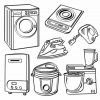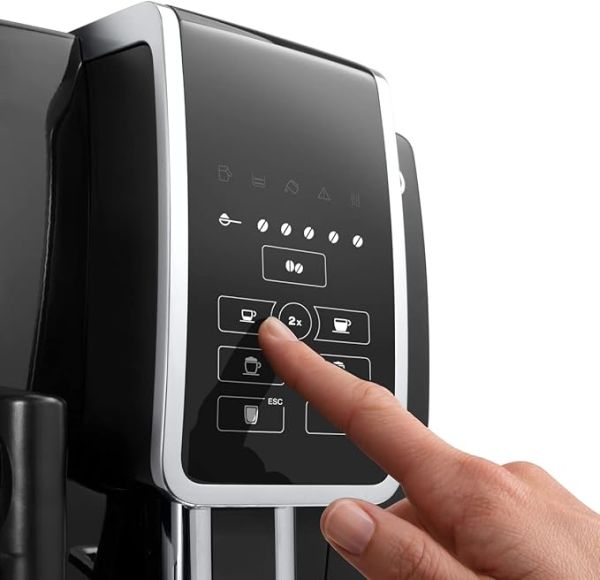Top 10 Smart Kitchen Appliances for Modern Homes

- Quick comparison
- 1) Smart refrigerator
- 2) Smart wall oven or range
- 3) Smart microwave
- 4) Smart dishwasher
- 5) Smart coffee maker or espresso machine
- 6) Smart air fryer or toaster oven
- 7) Smart multicooker/pressure cooker
- 8) Smart blender
- 9) Smart sous-vide circulator
- 10) Smart kitchen scale and thermometer
- Buying guide: how to choose the right smart appliance
- Feature checklist
- Installation, maintenance, and security
- Real-world combos that save time
- Energy and sustainability benefits
- FAQs
- Conclusion
Smart kitchens are no longer a sci-fi fantasy. Connected appliances weave timers, sensors, and apps into everyday cooking so meals finish on schedule and clean-up happens with fewer surprises. Instead of juggling knobs and sticky notes, you can preheat the oven from the couch, ask a speaker to start the coffee, or receive a ping when the dishwasher detects low rinse aid. The real value comes from consistency. When temperatures, pressures, and recipes are automated, results become repeatable, which means tastier food, fewer ruined batches, and less stress on busy weeknights.
Quick comparison
| Appliance | Best for | Key smart features | Typical price |
|---|---|---|---|
| Smart refrigerator | Meal planners, families | App temperature control, interior camera, inventory tools | $$$$ |
| Smart wall oven or range | Frequent bakers, hosts | Remote preheat, probe automation, guided recipes | $$$ |
| Smart microwave | Speed and convenience | Sensor reheat, barcode presets, app scheduling | $$ |
| Smart dishwasher | Busy households | Soil sensors, auto-dose, leak alerts | $$$ |
| Smart coffee or espresso | Daily caffeine lovers | Wake-up schedules, profiles, descaling reminders | $$–$$$ |
| Smart air fryer or toaster oven | Weeknight speed | Multi-stage cooks, temp tracking, food probe | $$ |
| Smart multicooker/pressure cooker | One-pot meals | Guided modes, safety interlocks, keep-warm | $$ |
| Smart blender | Smoothies and soups | Jar recognition, nutrient tracking, cleaning cycle | $$–$$$ |
| Smart sous-vide circulator | Precision proteins | Temperature graphs, finish-time prediction | $–$$ |
| Smart scale and thermometer | Accuracy upgrades | Recipe scaling, doneness alarms, watch alerts | $–$$ |
1) Smart refrigerator
A smart refrigerator is the command center of a connected kitchen. Adjustable zones, humidity control, and precise temperature graphs protect produce and proteins while cutting energy waste. Interior cameras let you check shelves from the grocery store to avoid duplicate purchases. Door-left-open, filter replacement, and power-outage alerts prevent costly surprises. Shopping integrations turn inventory into lists, and some models sync expiration dates so leftovers are used instead of tossed. Choose twin evaporators for better moisture balance, sturdy spill-proof shelves for easy cleanup, and a quiet, efficient compressor so the appliance fades into the background during family time.
Standout features: temperature graphs, camera access, restock suggestions, filtered water monitoring, quiet compressors.
Best for: households that plan weekly menus, bulk shoppers, home entertainers.
2) Smart wall oven or range
Connected ovens and ranges eliminate guesswork. Remote preheating saves minutes, while probe automation switches to keep-warm the moment a roast hits its target temperature. Guided recipes program time, rack position, and convection levels automatically, ensuring new dishes succeed on the first try. Air-fry and steam-assist expand versatility without extra gadgets. Consider telescoping racks for safety when handling heavy Dutch ovens. Verify auto-shutoff, lockout modes, and fume-free cleaning options, especially in open-plan spaces where ventilation is limited, and make sure the display remains readable under bright kitchen lighting.
Standout features: remote preheat, probe automation, steam-assist, air-fry, scheduled self-clean, safety locks.
Best for: frequent bakers, dinner party hosts, precision cooks.
3) Smart microwave
Modern smart microwaves tackle two pain points: inconsistent reheats and confusing presets. Sensor reheat monitors steam to adjust time and power dynamically, producing evenly warmed leftovers. Barcode scanning maps packaged foods to tested programs, and app control lets you build custom presets and share them with family. Compact models suit renters and dorm-style kitchens yet still support voice assistants for hands-free starts. For delicate foods, inverter technology keeps power steady rather than pulsing, which protects textures for dishes like custards, chocolate, and fish without constant supervision.
Standout features: sensor reheat, barcode presets, inverter power, silent mode, app recipes and timers.
Best for: small spaces, quick meals, families that reheat often.
4) Smart dishwasher
A smart dishwasher brings clean results with less babysitting. Soil sensors and load recognition fine-tune spray pressure and cycle length, saving water and power when dishes are only lightly soiled. Auto-dose dispensers deliver exact detergent amounts per cycle, improving results and protecting glassware. Remote start and delay-until-off-peak scheduling help manage energy costs if your utility offers time-of-use rates. App diagnostics flag clogs, rinse-aid levels, or door seal wear before performance drops. For quiet homes, look for sub-45 dBA operation, stainless-steel tubs for heat retention, and auto-open doors that vent steam to speed drying.
Standout features: auto-dose, soil sensors, targeted spray maps, app diagnostics, quiet night cycles, auto-open drying.
Best for: busy families, entertainers, homes with open floor plans.
5) Smart coffee maker or espresso machine
Smart coffee gear merges ritual with repeatability. Schedule wake-up brews, set weekday and weekend routines, and save strength profiles for each person in the house. Grinder-equipped espresso machines benefit from app-tuned grind and temperature curves, producing consistent shots even with new beans. Milk systems offer profiles for cappuccino, latte, and flat white, while cleaning reminders keep steam paths sanitary. For drip machines, look for a true bloom phase and temperature stability around 195–205°F to ensure even extraction. If your tap water is hard, pair the machine with a filter and follow descaling alerts to protect flow and flavor.
Standout features: user profiles, precise temperature, grinder integration, maintenance tracking, voice routines.
Best for: daily caffeine lovers, remote-work mornings, multi-person households.
6) Smart air fryer or toaster oven
Air fryers and smart toaster ovens excel at fast, crispy results without gallons of oil. App programs chain steps—preheat, roast, broil—so wings, vegetables, and frozen snacks finish at the same time. Real-time temperature tracking and food probes reduce guesswork, and some models double as dehydrators, proofers, or pizza ovens. Capacity matters: families should favor a sheet-pan-sized oven, while solo cooks can choose compact baskets that heat quickly and store easily. Removable, dishwasher-safe trays simplify cleanup, and smoke control features keep alarms quiet when you’re cooking high-fat foods like bacon or sausage.
Standout features: multi-stage cooks, probe support, dehydrator modes, smoke control, app program sharing.
Best for: renters, snackers, weeknight speed cooking.
7) Smart multicooker/pressure cooker
A smart multicooker is a Swiss Army knife that replaces several gadgets. It sautés aromatics, pressure cooks beans in minutes, slow cooks stews, steams dumplings, and even makes yogurt. Connected guidance walks beginners through safe pressure-release procedures, while lid sensors prevent opening under pressure. Recipes can auto-adjust for altitude and pot size. Meal preppers can batch cook with delayed start and programmable keep-warm, then portion for the week. Stainless steel inner pots resist scratches and tolerate metal utensils; nonstick is easier to clean but needs gentler tools and occasional replacement to maintain performance.
Standout features: guided pressure control, delayed start, sauté sear, yogurt mode, safety interlocks, firmware updates.
Best for: one-pot meals, batch cooking, new cooks learning fundamentals.
8) Smart blender
A smart blender pairs a powerful motor with jar recognition and closed-loop speed control so textures stay consistent from smoothie to smoothie. App programs track servings and estimated nutrition, which helps with training plans or calorie goals. Pulse, chop, and hot-blend modes expand use from icy drinks to silky purées and steaming soups. Noise-dampening housings protect conversations in open kitchens. For longevity, look for metal drive couplings, cooling airflow, and overcurrent protection. If easy cleaning is a priority, choose a dishwasher-safe jar and an auto-clean cycle that runs warm water and soap at high speed.
Standout features: jar recognition, nutrient tracking, hot-blend programs, vacuum add-ons, auto-clean.
Best for: smoothie fans, meal preppers, plant-forward cooks.
9) Smart sous-vide circulator
Sous-vide devices heat water precisely, delivering edge-to-edge doneness for steaks, salmon, eggs, and custards. Smart circulators let you schedule finish times and watch temperature graphs from the couch. That predictability eases entertaining: start proteins early, then sear just before serving. Choose at least 1000 W for faster heat-up in larger containers, and verify clamp compatibility with your pots or polycarbonate tubs. A lid or even ping-pong balls reduce evaporation on long cooks. Pair with a cast-iron skillet or torch for finishing sears that add color and flavor without overcooking delicate interiors.
Standout features: precise graphs, finish-time prediction, robust clamps, quiet pumps, over-the-air updates.
Best for: precision proteins, make-ahead dinners, science-minded cooks.
10) Smart kitchen scale and thermometer
A smart scale and a connected thermometer upgrade every other appliance. The scale enables recipe scaling by weight, improving consistency for bread, pasta, and pastries. Guided apps show when to add the next ingredient and auto-convert between grams and cups. Meanwhile, an instant-read thermometer or multi-probe hub tracks meats, smoker temps, and oven stability with alerts to your phone or watch. Look for waterproof probes, replaceable batteries, and magnetic mounts. Bakers benefit from 0.1-gram resolution for levain and spices, while grillers prefer high-heat probes with braided cables that survive repeated cooks without drifting.
Standout features: recipe-scaling guidance, watch alerts, cloud graphs, fine resolution, rugged probes.
Best for: accuracy hunters, bakers, barbecue fans.
Buying guide: how to choose the right smart appliance
Selecting the best device involves matching features to your kitchen, habits, and budget. Start with compatibility: does it support your preferred assistant and home platform? Evaluate Wi-Fi strength near the appliance; thick walls and older microwaves can interfere, so a mesh node may help. Next, consider reliability. Stainless tubs, metal drives, and modular parts typically outlast plastic equivalents. Energy consumption matters too: look for Energy Star where applicable, eco modes, and power-down schedules. Examine app quality before buying. Screenshots reveal whether timers, logs, and alerts are readable, searchable, and exportable. Finally, check serviceability: can you buy filters, gaskets, racks, trays, or probes easily, and does the manual explain user-replaceable maintenance without voiding the warranty?
Feature checklist
| Feature | Why it matters | Minimum to look for |
|---|---|---|
| Connectivity | Stable control and updates | Dual-band Wi-Fi, Bluetooth fallback |
| Voice support | Hands-free commands | Alexa, Google, or Apple Home |
| App quality | Usability and reliability | Offline modes, exportable logs |
| Sensors | Accurate automation | Temp, humidity, soil, or weight as relevant |
| Efficiency | Lower cost of ownership | Energy Star where supported |
| Safety | Peace of mind | Auto-shutoff, locks, alerts |
| Serviceability | Long-term value | Replaceable filters and parts |
Installation, maintenance, and security
Smart appliances are still appliances, so fundamentals matter: level surfaces, dedicated circuits, and proper clearances. Follow ventilation guidance for ovens, microwaves, and air fryers; heat damage from cramped cabinets is common. For dishwashers and fridges, use braided stainless hoses and place leak detectors nearby. Replace water filters on schedule; a clogged filter strains pumps and worsens taste. Keep firmware updated but avoid public Wi-Fi. Create a separate IoT network if your router supports it, turn off remote access you do not use, and set unique passwords per device. Regularly clean seals, descaling paths, and intake screens to protect performance.
Real-world combos that save time
-
Multicooker + smart scale: batch cook grains and proteins, then portion accurately for the week.
-
Air fryer + smart thermometer: finish chicken to crispy perfection with alerts preventing overcooking.
-
Oven + sous-vide: sear and serve precisely timed steaks alongside roasted vegetables.
-
Fridge + dishwasher: reduce waste with expiry reminders and reliable sanitizing cycles.
Energy and sustainability benefits
Smart appliances reduce waste in three complementary ways. First, sensors prevent overcooking, food spoilage, and detergent overdosing, lowering landfill impact and grocery costs. Second, connected scheduling nudges heavy tasks—dishwashing, preheating, and bread proofing—into off-peak windows when grids are cleaner and rates are lower. Third, usage reports make costs visible, turning vague guesses into targets the whole family can improve together. Simple habits compound: run auto-dose cycles, enable eco modes, empty trays, keep seals clean, and prefer air-dry when dishes allow. Small improvements add up monthly, measurably, yielding food with less energy, less water, and less stress.
FAQs
Do smart appliances require subscriptions? Many do not. When subscriptions exist, they usually add recipe libraries, cloud video for fridge cameras, or extended analytics. Always compare core features without fees.
Will they work during an internet outage? Most appliances operate locally, though remote features pause. Choose models with robust on-device controls and offline timers so dinner does not depend on the cloud.
Are smart devices safe around kids? Yes when used properly. Look for locks, auto-shutoff, and tip or door sensors; teach children to avoid hot surfaces and steam.
How long should a smart appliance last? Similar to traditional gear—often seven to fifteen years—if maintained. Favor brands with parts catalogs and clear maintenance schedules so repairs are realistic.
Conclusion
The best smart kitchen appliances do more than add a shiny app. They automate drudgery, preserve food quality, and make great results repeatable. Use the tables and checklists above to match features to your space, then start with one or two upgrades that solve daily friction. Build from there and your modern kitchen will feel effortless.








